Alternative topologies overview
This page describes the Alternative ALM Deployment Topologies for version 6.0.0 to 6.0.4. Refer to
Standard deployment topologies overview for high-level description of the standard topologies, how they are categorized and their key characteristics.
These alternative deployment topologies for the Rational solution for Application Lifecycle Management (ALM) are a subset of the standard ALM deployment topologies. For the rest of the standard topologies, see
Recommended ALM deployment topologies 6.x.
Alternate departmental topologies
(ALM-D1) Departmental - Single application server / Windows / DB2
This departmental topology uses Microsoft Windows for the server operating systems. The ALM applications and JTS are deployed to a single WAS instance. A
reverse proxy server is used to ensure public URI stability. DB2 is used for the databases and is hosted on a separate server. Jazz Reporting Service (JRS) is included in this department configuration and the Data Collection Component (DCC) is hosted on a separate server and WAS instance for performance reasons. Finally, licenses are served by a floating license server and Active Directory provides the
Lightweight Directory Access Protocol (LDAP) based user management. Note that the VVC application is only present in release 6.0 and has been incorporated in other applications in later releases. Additionally, Rhapsody Model Manager, first available in version 6.0.5, is now the recommended architecture management tool.
| Metadata Variable |
Value |
| Operating System |
Microsoft Windows |
| Database Management System |
DB2 |
| Application Server |
WebSphere |
| License Management System |
Floating |
| User Management System |
Microsoft Active Directory |
| Other technologies |
Reverse Proxy |
- ALM-D1 Topology Diagram for v6.x:

(ALM-D2) Departmental - Single application server / Windows / Oracle
This departmental topology uses Microsoft Windows for the server operating systems. The ALM applications and JTS are deployed to a single WAS instance. A
reverse proxy server is used to ensure public URI stability. Oracle is used for the databases and is hosted on a separate server. Jazz Reporting Service (JRS) is included in this department configuration and the Data Collection Component (DCC) is hosted on a separate server and WAS instance for performance reasons. Finally, licenses are served by a floating license server and Active Directory provides the
LDAP based user management. Note that the VVC application is only present in release 6.0 and has been incorporated in other applications in later releases. Additionally, Rhapsody Model Manager, first available in version 6.0.5, is now the recommended architecture management tool.
| Metadata Variable |
Value |
| Operating System |
Microsoft Windows |
| Database Management System |
Oracle |
| Application Server |
WebSphere |
| License Management System |
Floating |
| User Management System |
Microsoft Active Directory |
| Other technologies |
Reverse Proxy |
- ALM-D2 Topology Diagram for v6.x:
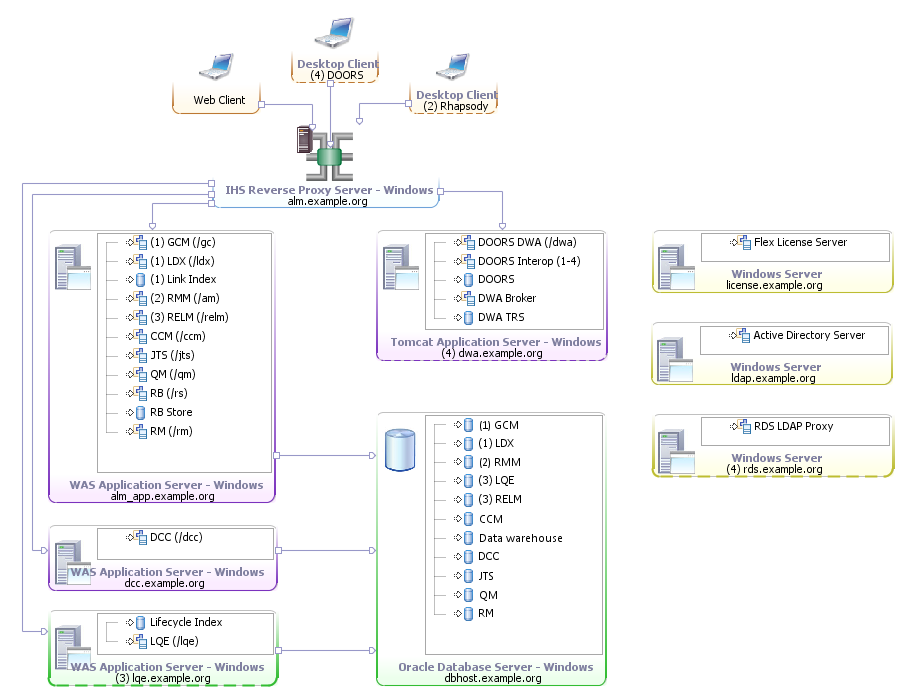
(ALM-D3) Departmental - Single application server, Linux / Oracle
This departmental topology uses Red Hat Enterprise Linux for the server operating systems. The ALM applications and JTS are deployed to a single WAS instance. A
reverse proxy server is used to ensure public URI stability. Oracle is used for the databases and is hosted on a separate server. Jazz Reporting Service (JRS) is included in this department configuration and the Data Collection Component (DCC) is hosted on a separate server and WAS instance for performance reasons. Finally, licenses are served by a floating license server and Tivoli Directory Server provides the
LDAP based user management. Note that the VVC application is only present in release 6.0 and has been incorporated in other applications in later releases. Additionally, Rhapsody Model Manager, first available in version 6.0.5, is now the recommended architecture management tool.
| Metadata Variable |
Value |
| Operating System |
Red Hat Enterprise Linux |
| Database Management System |
Oracle |
| Application Server |
WebSphere |
| License Management System |
Floating |
| User Management System |
Tivoli Directory Server |
| Other technologies |
Reverse Proxy |
- ALM-D3 Topology Diagram for v6.x:
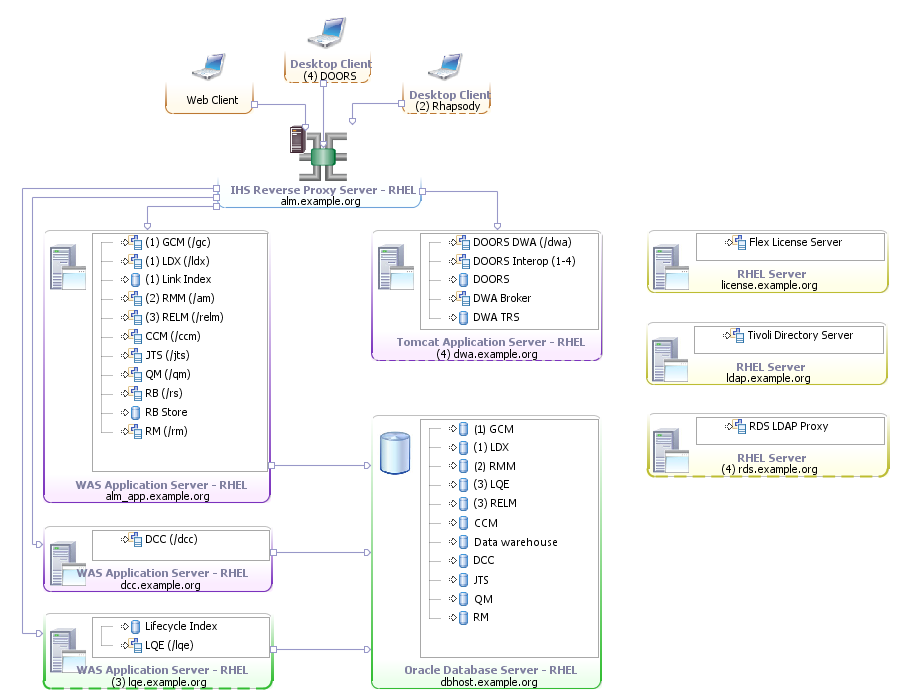
(ALM-D4) Departmental - Single application server, Linux / DB2
This departmental topology uses Red Hat Enterprise Linux for the server operating systems. The ALM applications and JTS are deployed to a single WAS instance. A
reverse proxy server is used to ensure public URI stability. DB2 is used for the databases and is hosted on a separate server. Jazz Reporting Service (JRS) is included in this department configuration and the Data Collection Component (DCC) is hosted on a separate server and WAS instance for performance reasons. Finally, licenses are served by a floating license server and Tivoli Directory Server provides the
LDAP based user management. Note that the VVC application is only present in release 6.0 and has been incorporated in other applications in later releases. Additionally, Rhapsody Model Manager, first available in version 6.0.5, is now the recommended architecture management tool.
| Metadata Variable |
Value |
| Operating System |
Red Hat Enterprise Linux |
| Database Management System |
DB2 |
| Application Server |
WebSphere |
| License Management System |
Floating |
| User Management System |
Tivoli Directory Server |
| Other technologies |
Reverse Proxy |
- ALM-D4 Topology Diagram for v6.x:
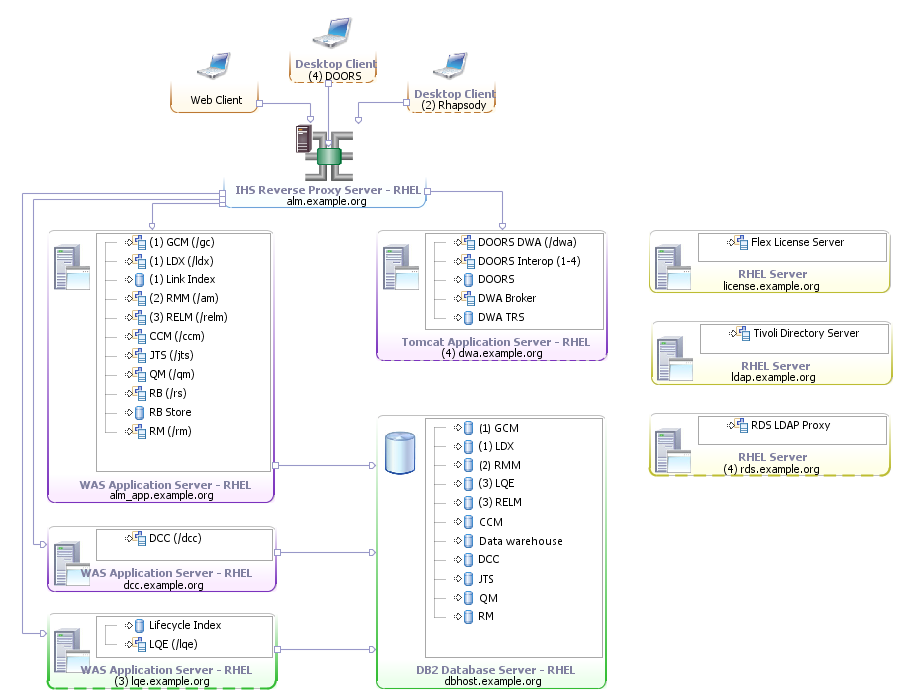
Alternate enterprise topologies
(ALM-E2) Enterprise - Distributed / Windows / SQL Server
This enterprise topology uses Microsoft Windows for the server operating systems. It includes both DNG and DOORS/DWA as RM applications. The applications are distributed across separate servers and WAS instances. A
reverse proxy is used to ensure public URI stability. Microsoft SQL Server is used for the databases and is hosted on a separate server. Finally, licenses are served by a floating license server and Windows Active Directory Server provides the
LDAP based user management. Note that the VVC application is only present in release 6.0 and has been incorporated in other applications in later releases. Additionally, Rhapsody Model Manager, first available in version 6.0.5, is now the recommended architecture management tool. If Rhapsody Design Manager continues to be used, it should be deployed on its own server.
| Metadata Variable |
Value |
| Operating System |
Microsoft Windows |
| Database Management System |
Microsoft SQL Server |
| Application Server |
WebSphere |
| License Management System |
Floating |
| User Management System |
Microsoft Active Directory |
| Other technologies |
Reverse Proxy |
- ALM-E2 Topology Diagram for v6.x:

(ALM-E4) Enterprise - Power Server / AIX / DB2
This enterprise topology uses AIX for the server operating systems. The applications share a single WAS instance except for LQE and DCC which are split out on individual LPARs for performance reasons. A
reverse proxy is used to ensure public URI stability. DB2 is used for the databases and is hosted on a separate AIX LPAR. Finally, licenses are served by a floating license server and Tivoli Directory Server provides the
LDAP based user management.
| Metadata Variable |
Value |
| Operating System |
AIX |
| Database Management System |
DB2 |
| Application Server |
WebSphere |
| License Management System |
Floating |
| User Management System |
Tivoli Directory Server |
| Other technologies |
Reverse Proxy |
- ALM-E4 Topology Diagram for v6.x:
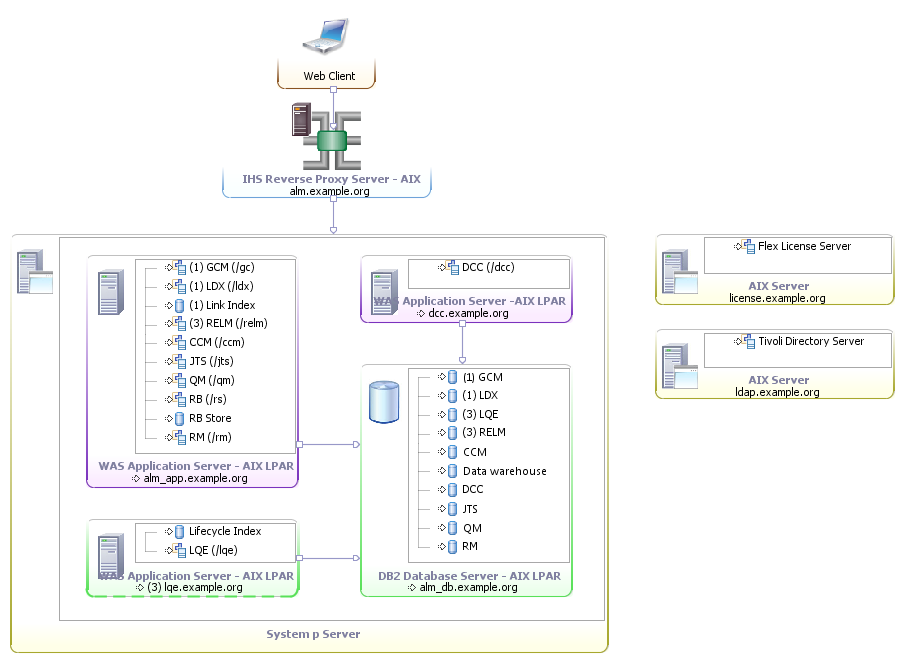
(ALM-E5) Enterprise - Mainframe / zLinux / DB2
This enterprise topology uses Linux for System z for the server operating systems. The applications are run in separate profiles on a single WAS instance. A
reverse proxy is used to ensure public URI stability. DB2 for z/OS is used for the databases and is hosted on a separate z/OS based LPAR. Finally, licenses are served by a floating license server and Tivoli Directory Server provides the LDAP based user management.
| Metadata Variable |
Value |
| Operating System |
Linux on System z |
| Database Management System |
DB2 for z/OS |
| Application Server |
WebSphere |
| License Management System |
Floating |
| User Management System |
Tivoli Directory Server |
| Other technologies |
Reverse Proxy |
- ALM-E5 Topology Diagram for v6.x:
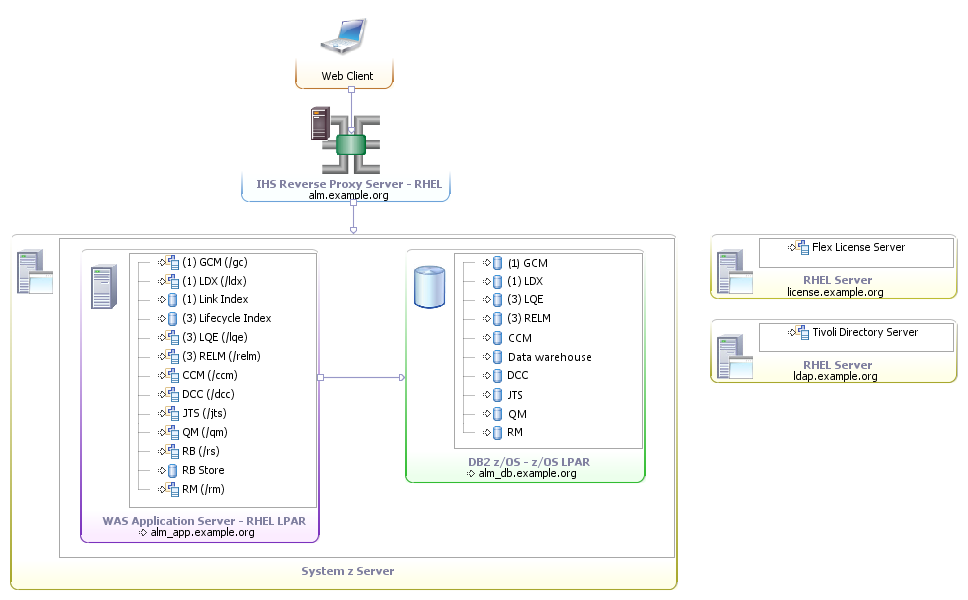
(ALM-E6) Enterprise - Mainframe / zOS / DB2
This enterprise topology uses IBM z/OS for the server operating systems. The applications are run in separate profiles on a single WAS instance. A
reverse proxy is used to ensure public URI stability. DB2 for z/OS is used for the databases and is hosted on a separate LPAR. Finally, licenses are served by a floating license server and RACF provides the user management.
| Metadata Variable |
Value |
| Operating System |
IBM z/OS |
| Database Management System |
DB2 for z/OS |
| Application Server |
WebSphere |
| License Management System |
Floating |
| User Management System |
RACF |
| Other technologies |
Reverse Proxy |
- ALM-E6 Topology Diagram for v6.x:
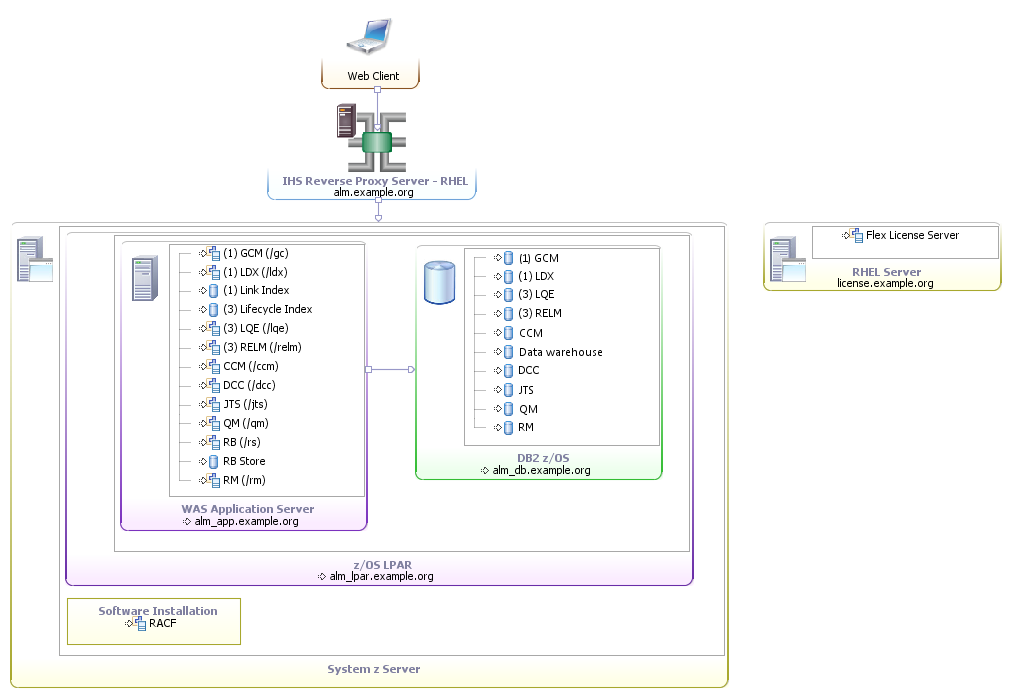
Applying the topologies
Every customer's environment is different with unique, necessary and often immutable requirements and constraints. We recognize that these standard topologies may not provide enough detail to make them immediately implementable in some customer environments, but we wanted to describe several topologies with enough variability to give an indication of what is possible and where our recommendations start.
While we recommend customers start with a standard topology that is most applicable to them, we recognize they will need to make changes and customizations to support their own unique requirements and constraints. IBM will support your own implementations, but may ask you to describe which topology is most applicable to your deployment and ask you to document what is unique in your environment to expedite any potential support situation.
To aid you in documenting your chosen deployment topology, we have made the following Rational Software Architect (RSA) model files available:
These may be imported into RSA then further modified or expanded to represent your environment. Look at the Installation_Instructions.txt file for information on how to import the models into RSA.
Datasheets and sizing guidelines
Find ALM-specific performance datasheets, sizing guidelines and performance-related case studies on the
Performance datasheets and sizing guidelines page.
Next steps
This topic is meant to briefly introduce these standard topologies and describe how they might be applied. Work is already underway to build upon and apply them. Subsequent updates to this topic and supporting topics will provide additional insight into their usage.
Future updates to this topic or supporting topics may cover:
- Deeper look at select topologies
- Provide suggested tuning parameters
- Consider high availability database topologies
- Begin to expand this topology model into other domains
- Discussion of strategic integrations with other IBM and non-IBM products.
Additional contributors: IanCompton







